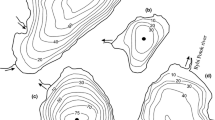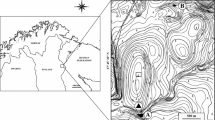Abstract
Lake Ringsjön in southern Sweden was restored by biomanipulation by means of a reduction in zooplanktivorous cyprinids. The fish community in the three different Basins of Lake Ringsjön were followed between 1987 and 1994. In 1990, c. 100 tons (60% of the community) were removed from Sätofta Basin, in 1988, c. 500 tons (80%) were removed from Eastern Basin and in 1992, c. 120 tons (50%) of cyprinids were removed from Western Basin. In all basins, the fish biomass was much lower after fish reduction than before, but only in Eastern Basin has the proportion of piscivores increased substantially (from 10% to 25–40%). Due to very high abundance of young-of-the-year following the fish reductions, the fish abundance has increased in all basins. The abundance of the young-of-the-year was negatively correlated to the abundance of piscivore perch at the 3 m depth. Although the young-of-the-year abundance was very high after the fish reduction, there are no clear evidences that this affects recruitment to the adult populations. The results are discussed in relation to critical fish biomasses and critical proportions of planktivory and piscivory to ensure a long lasting effect of fish reduction.
Similar content being viewed by others
References
Andersson, G. H., H. Berggren, G. Cronberg & C. I. Gelin, 1978. Effects of planktivorous fish on organisms and water chemistry in eutrophic lakes. Hydrobiologia 59: 9–15.
Benndorf, J., 1990. Conditions for effective biomanipulation; conclusions derived from whole-lake experiments in Europe. Hydrobiologia 200/201: 187–204.
Benndorf, J., 1995. Possibilities and limits for controlling eutrophication by biomanipulation. Int. Rev. Ges. Hydrobiologia 80: 519–534.
Brabrand, Å., B. A. Faafeng & J. P. Nilssen, 1986. Juvenile roach and invertebrate predators: delaying the recovery phase of eutrophic lakes by suppression of efficient filter feeders. J. Fish. Biol. 29: 99–106.
Brabrand, Å., B. A. Faafeng & J. P. M. Nilssen, 1990. Relative importance of phosphorus supply to phytoplankton production: Fish excretion versus external loading. Can. J. Fish Aquat. Sci. 47: 364–372.
Carpenter, S. R., J. F. Kitchell & J. R. Hodgson, 1985. Cascading trophic interactions and lake productivity. BioScience 35: 634–639.
Collette, B. B., M. A. Ali, K. E. F. Hokanson, M. Nagiec, S. A. Smirnov, A. H. Thorpe, A. H. Weatherley, & J. Willemsen, 1977. Biology of Percids. J. Fish. Res. Bd Can. 34: 1890–1899.
Hamrin, S. F., 1993. Lake restoration by cyprinid control in Sätofta Bay (Lake Ringsjön). Verh. Int. Ver. Limnol. 25: 487–493.
Hamrin, S. F., 1999. Planning and excecution of the fish reduction in Lake Ringsjön. Hydrobiologia 404: 59–63.
Hamrin, S. F., E. Bergstrand, G. Cronberg & P. Romare, 1991. Lake restoration by cyprinid reduction. The development of Lake Ringsjön since 1966 and effects of the fish reduction 1988–1990. Mimeographed. Department of Limnology, Lund. (In Swedish).
Hamrin, S. F., E. Bergstrand, G. Cronberg, A. Persson, P. Romare, & J. Strand, 1993. Lake restauration by cyprinid reduction. The development of Lake Ringsjön during the period 1987–1992. Sjörestaurering genom cyprinidreduktion. Ringsjöns utveckling under perioden 1987–1992. Mimeographed. Department of Limnology in Lund and Institute of Freshwater Research in Drottningholm. (In Swedish).
Hansson, L.-A., M. Enell & E. Bergman, 1999. Lake Ringsjön: its catchment area, its history and its importance. Hydrobiologia 404: 1–7.
Hartman, J. & W. Nümann, 1977. Percids in Lake Constance, a lake under eutrophication. J. Fish. Res. Bd. Can. 34: 1670–1677.
Henrikson, L., H. G. Nyman, H. G. Oscarson & J. A. E. Stenson, 1980. Trophic changes without changes in the external nutrient loading. Hydrobiologia 68: 257–263.
Horppila J. & T. Kairesalo, 1990. A fading recovery: the role of roach (Rutilus rutilus L.) in maintaining high phytoplankton productivity and biomass in Lake Vesijärvi, southern Finland. Hydrobiologia 200/201: 153–165.
Horppila, J., K. Nyberg, H. Peltonen & T. Turunen, 1996. Effects of five years of intensive trawling on a previously unexploited smelt stock. J. Fish Biol. 48: 329–340.
Jeppesen, E., J. P Jensen, P. Kristensen, M. Søndergaard, E. Mortensen, O. Sortkjær & K. Olrik, 1990a. Fish manipulation as a lake restoration tool in shallow, eutrophic temperate lakes 2: threshold levels, long-term stability and conclusions. Hydrobiologia 200/201: 219–227.
Jeppesen, E., M. Søndergaard, E. Mortensen, P. Kristensen, B. Riemann, H. J. Jensen, J. P. Müller, O. Sortkjær, J. P. Jensen, K. Christoffersen, S. Bosselmann & E. Dall, 1990b. Fish manipulation as a lake restoration tool in shallow, eutrophic temperate lakes 1: cross-analysis of three Danish case-studies. Hydrobiologia 200/201: 205–218.
Kitchell, J. F. (Ed.) 1992. Food Web Management. A case study of lake Mendota. Springer–Verlag, New York.
Lampert, W., W. Flecker, H. Rai & B. E. Taylor, 1986. Phytoplankton control by grazing zooplankton: A study on the spring clear-water phase. Limnol. Oceanogr. 31: 478–490.
Leopold, M., M. Bni'nska & W. Nowak, 1986. Commercial fish catches as an index of lake eutrophication. Arch. Hydrobiol. 106: 513–524.
Lessmark, O., 1983. Competition between perch (Perca fluviatilis) and roach (Rutilus rutilus) in south Swedish lakes. Dissertation. Institute of Limnology, University of Lund, Sweden. 172 pp.
Meijer, M.-L., E. Jeppesen, E. van Donk, B. Moss, M. Scheffer, E. H. R. R. Lammens, E. H. van Nes, B. Faafeng & J.P. Jensen, 1994. Long term responses on fish stock reduction in small shallow lakes. Interpretation of five year results of four biomanipulation cases in The Netherlands and Denmark. Hydrobiologia 275/276: 457–466.
Meijer, M.-L., E. H. R. R. Lammens, A. J. P. Raat, J. G. P. Klein Breteler & M. P. Grimm, 1995. Development of fish communities in lakes after biomanipulation. Neth. J. Aquat. Ecol. 29: 91–101.
Oksanen, L., S. D. Fretwell, J. Arruda, & P. Niemelä, 1981. Exploitation ecosystems in gradients of primary productivity. Am Nat 118: 240–261.
Persson, A., 1997. Effects of fish predation and excretion on the configuration of aquatic food webs. Oikos 79: 137–146.
Persson, L., G. Andersson, S. F. Hamrin & L. Johansson, 1988. Predator regulation and primary production along the productivity gradient of temperate lake ecosystems. In S. R. Carpenter (ed.), Complex Interactions in Lake Communities. Springer-Verlag. New York: 45–65.
Persson, L., S. Diehl, L. Johansson, G. Andersson & S. F. Hamrin, 1991. Shifts in the fish communities along the productivity gradient of temperate lakes – patterns and the importance of size-structured interactions. J. Fish. Biol. 38: 281–293.
Riemann, B., K. Christoffersen, H. J. Jensen, J. P. Müller, C. Lindegaard & S. Bosselmann, 1990. Ecological consequences of a manual reduction of roach and bream in a eutrophic, temperate lake. Hydrobiologia 200/201: 241–250.
Schriever, P., J. Bøgestrand, E. Jeppesen & M. Søndergaard, 1995. Impact of submersed macrophytes on fish-zooplanktonphytoplankton interactions: large-scale enclosure experiments in a shallow eutrophic lake. Freshwat. Biol. 33: 255–270.
Shapiro, J., 1995. Lake Restoration by biomanipulation – a personal view. Envir. Rev. 3: 83–93.
Søndergaard, M., E. Jeppesen, E. Mortensen, E. Dall, P. Kristensen & O. Sortkjær, 1990. Phytoplankton biomass reduction after planktivorous fish reduction in a shallow, eutrophic lake: a combined effect of reduced internal P-loading and increased zooplankton grazing. Hydrobiologia 200/201: 220–240.
van Donk, E., M. P. Grimm, R. D. Gulati, P. G. M. Heuts, W. A. de Kloet & E. van Liere, 1990a. First attempt to apply wholelake food-web manipulation on a large scale in The Netherlands. Hydrobiologia 200/201: 291–302.
van Donk, E., M. P. Grimm, R. D. Gulati & J. P. G. Klein Breteler, 1990b. Whole-lake food-web manipulation as a means to study community interactions in a small ecosystem. Hydrobiologia 200/201: 275–290
Wright, D. & J. Shapiro, 1990. Refuge availability: a key to understanding the summer disappearance of Daphnia. Freshwat. Biol. 24: 43–62.
Author information
Authors and Affiliations
Rights and permissions
About this article
Cite this article
Bergman, E., Hamrin, S.F. & Romare, P. The effects of cyprinid reduction on the fish community. Hydrobiologia 404, 65–75 (1999). https://doi.org/10.1023/A:1003713705972
Issue Date:
DOI: https://doi.org/10.1023/A:1003713705972




